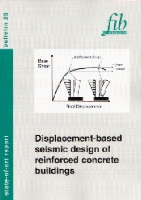Displacement-based seismic design of reinforced concrete buildings (PDF)
State-of-art report (196 pages, ISBN 978-2-88394-065-9, August 2003) - PDF format
fib Bulletin No. 25
Title: Displacement-based seismic design of reinforced concrete buildings
Category: State-of-art report
Year: 2003
Pages: 196
Format approx. DIN A4 (210x297 mm)
ISBN: 978-2-88394-065-9
DOI: doi.org/10.35789/fib.BULL.0025
Abstract:
A brief summary of the history of seismic design as given in chapter 1, indicates that initially design was purely based on strength or force considerations. When the importance of displacement, however, became better appreciated, it was attempted to modify the existing force-based approach in order to include considerations of displacement, rather than to totally reconsider the procedure on a more rational basis.
In the last decade, then, several researchers started pointing out this inconsistency, proposing displacement-based approaches for earthquake engineering evaluation and design, with the aim of providing improved reliability in the engineering process by more directly relating computed response and expected structural performance.
The main objective of this report is to summarize, critically review and compare the displacement - based approaches proposed in the literature, thus favouring code implementation and practical use of rational and reliable methods.
Chapter 2 Seismic performance and design objectives of this report introduces concepts of performance levels, seismic hazard representation, and the coupling of performance and hazard to define performance objectives. In fact, for displacement analysis to be relevant in the context of performance-based design, the structural engineer must select appropriate performance levels and seismic loadings. A critical review of some engineering limit states appropriate to the different performance levels is therefore proposed.
In chapter 3 Conceptual basis for displacement-based earthquake resistant design, the fundamental principles associated with displacement of the ground during an earthquake and the effects, in terms of displacement, in the structure, are reviewed. The historical development guides the presentation with a review of general linear and nonlinear structural dynamics principles, general approaches to estimate displacement, for both ground and structure, and finally a general presentation of the means to measure and judge the appropriateness of the displacements of the structure in section.
Chapter 4 Approaches and procedures for displacement-based design can be somehow considered the fundamental part of the report, since a critical summary of the displacement - based approaches proposed by different researchers is presented there.
Displacement - based design may require specific characterization of the input ground motion, a topic addressed in Chapter 5 Seismic input. In general, various pertinent definitions of input motion for non-code format analysis are included, while peak ground parameters necessary for code base shear equations are only addressed as needed for the definition of motion for analysis.
Chapter 6 Displacement capacity of members and systems addresses the fundamental problem of evaluating the inelastic displacement capacity of reinforced concrete members and realistic values of their effective cracked stiffness at yielding, including effects of shear and inclined cracking, anchorage slip, bar buckling and of load cycling.
In Chapter 7 Application and evaluation of displacement-based approaches, some of the many different displacement based design procedures briefly introduced in Chapter 4 are applied to various case studies, identifying and discussing the difficulties a designer may encounter when trying to use displacement based design. Results for five different case studies designed in accordance with eight different displacement based design methods are presented.
Although in general case studies are considered a useful but marginal part of a state of the art document, in this case it has to be noted that chapter 7 is possibly the most innovative and fundamental part of the whole report. The conclusions of chapter 7 are the fundamental and essential conclusions of the document and allow foreseeing a bright future for displacement - based design approaches.
The state-of-art report has been elaborated over a period of 4 years by Task Group 7.2 Displacement-based design and assessment of fib Commission 7 Seismic design, a truly international team of experts, representing the expertise and experience of all the important seismic regions of the world. In October 2002 the final draft of the Bulletin was presented to the public during the 1st fib Congress in Osaka. It was also there that it was approved by fib Commission 7 Seismic Design.
- Objectives and scope - doi.org/10.35789/fib.BULL.0025.Ch01
- Seismic performance and design objectives - doi.org/10.35789/fib.BULL.0025.Ch02
- Conceptual basis for displacement-based earthquake resistant design - doi.org/10.35789/fib.BULL.0025.Ch03
- Approaches and procedures for displacement-based design - doi.org/10.35789/fib.BULL.0025.Ch04
- Seismic input - doi.org/10.35789/fib.BULL.0025.Ch05
- Displacement capacity of members and systems - doi.org/10.35789/fib.BULL.0025.Ch06
- Application and evaluation of displacement-based approaches - doi.org/10.35789/fib.BULL.0025.Ch077



